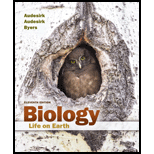
Concept explainers
Introduction:
Animals show different types of ecological behavior. These behaviors are linked to their survival and success of reproduction, which ensures the survival of their species. There are many factors such as environment and genes which influence such behavior. The type of behavior exhibited by animals in a particular situation depends on the interaction between the genes of the animal and the environment the animal is present in.
Answer to Problem 1MC
Correct answer:
Territoriality is a type of behavior shown by the male member of the lizard species.
Explanation of Solution
Explanation for the correct answer:
Option (c) is given that the territoriality is the reason that a male member of the lizard species protects or defends a certain area. This is true because territoriality refers to the protection of a certain area, especially one that has an abundance of crucial
Explanation for incorrect answers:
Option (a) is given that insight learning is the behavior exhibited by the male lizard. This is not true since insight learning basically means that an animal exhibits sudden problem-solving behavior, especially when it does not have any prior experience of the particular problem encountered. So, it is an incorrect option.
Option (b) is given that kin selection is the behavior exhibited by the male lizard in defending its territory. This is not true since kin selection is a type of non-aggressive behavior exhibited in which there is cooperation between members of an animal society. So, it is an incorrect option.
Option (d) is given that altruism is the behavior which is exhibited by the male lizard. This is not true since altruism refers to the behavior when an animal exhibits self-sacrificial behavior for the benefit of another animal. So, it is an incorrect option.
Hence, options, (a), (b), and (d) are incorrect.
Thus, it can be concluded that the behavior exhibited by a male lizard when it is defending a certain area is territoriality.
Want to see more full solutions like this?
Chapter 26 Solutions
Biology: Life on Earth (11th Edition)
- please fill in the empty sports, thank you!arrow_forwardIn one paragraph show how atoms and they're structure are related to the structure of dna and proteins. Talk about what atoms are. what they're made of, why chemical bonding is important to DNA?arrow_forwardWhat are the structure and properties of atoms and chemical bonds (especially how they relate to DNA and proteins).arrow_forward
- The Sentinel Cell: Nature’s Answer to Cancer?arrow_forwardMolecular Biology Question You are working to characterize a novel protein in mice. Analysis shows that high levels of the primary transcript that codes for this protein are found in tissue from the brain, muscle, liver, and pancreas. However, an antibody that recognizes the C-terminal portion of the protein indicates that the protein is present in brain, muscle, and liver, but not in the pancreas. What is the most likely explanation for this result?arrow_forwardMolecular Biology Explain/discuss how “slow stop” and “quick/fast stop” mutants wereused to identify different protein involved in DNA replication in E. coli.arrow_forward
- Molecular Biology Question A gene that codes for a protein was removed from a eukaryotic cell and inserted into a prokaryotic cell. Although the gene was successfully transcribed and translated, it produced a different protein than it produced in the eukaryotic cell. What is the most likely explanation?arrow_forwardMolecular Biology LIST three characteristics of origins of replicationarrow_forwardMolecular Biology Question Please help. Thank you For E coli DNA polymerase III, give the structure and function of the b-clamp sub-complex. Describe how the structure of this sub-complex is important for it’s function.arrow_forward
 Biology (MindTap Course List)BiologyISBN:9781337392938Author:Eldra Solomon, Charles Martin, Diana W. Martin, Linda R. BergPublisher:Cengage Learning
Biology (MindTap Course List)BiologyISBN:9781337392938Author:Eldra Solomon, Charles Martin, Diana W. Martin, Linda R. BergPublisher:Cengage Learning
 Biology: The Dynamic Science (MindTap Course List)BiologyISBN:9781305389892Author:Peter J. Russell, Paul E. Hertz, Beverly McMillanPublisher:Cengage Learning
Biology: The Dynamic Science (MindTap Course List)BiologyISBN:9781305389892Author:Peter J. Russell, Paul E. Hertz, Beverly McMillanPublisher:Cengage Learning Human Heredity: Principles and Issues (MindTap Co...BiologyISBN:9781305251052Author:Michael CummingsPublisher:Cengage Learning
Human Heredity: Principles and Issues (MindTap Co...BiologyISBN:9781305251052Author:Michael CummingsPublisher:Cengage Learning Comprehensive Medical Assisting: Administrative a...NursingISBN:9781305964792Author:Wilburta Q. Lindh, Carol D. Tamparo, Barbara M. Dahl, Julie Morris, Cindy CorreaPublisher:Cengage Learning
Comprehensive Medical Assisting: Administrative a...NursingISBN:9781305964792Author:Wilburta Q. Lindh, Carol D. Tamparo, Barbara M. Dahl, Julie Morris, Cindy CorreaPublisher:Cengage Learning





